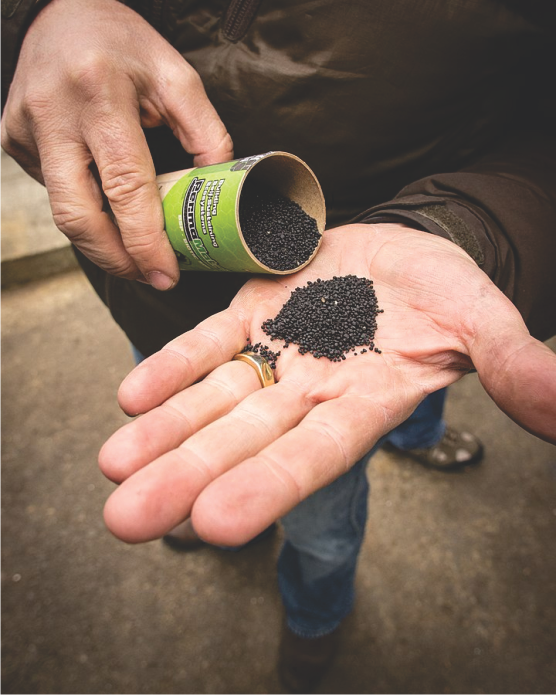by Rainer Hoenicke

If you could continually turn a lot of organic material into biochar, you could, over time, reverse the history of the last two hundred years…We can, literally, start sucking some of the carbon that our predecessors have poured into the atmosphere down through our weeds and stalks and stick it back in the ground. We can run the movie backward. We can unmine some of the coal, undrill some of the oil. We can take at least pieces of the Earth and – this is something we haven't done for quite a while – leave them Better Than We Found Them.
Bill McKibben, author, climate activist and founder of 350.org
Characteristics of Biochar
Biochar is essentially organic material that is heated at temperatures above 700 degrees F with limited oxygen supply - a process called pyrolysis. The carbon molecules in organic material are generally arranged in hydrocarbon chains, which are easily broken apart in the decomposition process. When burned in a low-oxygen environment, the material doesn't leave ash as a residue but turns into something very much akin to charcoal. The hydrocarbon chains in un-decomposed organic matter are transformed during this pyrolytic process into rings, which don't break down easily. Some call biochar “stabilized organic matter.” Carbon in biochar can persist in soils over long time scales. Beyond the carbon sequestered in the biochar itself, biochar incorporated in soils also offers numerous other potential benefits.
1) Soil Fertility and Biodiversity: Biochar can improve soil fertility, stimulating plant growth, which then consumes more CO2 in a positive feedback effect. Biochar can reduce the need for chemical fertilizers, resulting in reduced emissions of greenhouse gases from fertilizer manufacture. Biochar can increase soil microbial life, resulting in more carbon storage in soil. Soil carbon has been shown to double after six years of bioachar applications of 2-10 tons per acre. Biochar and compost complement each other. With as little as 8% by volume added to compost, biochar accelerates the decomposition process and greatly reduces losses of ammonia to the atmosphere by facilitating conversion of ammonia to nitrate.
2) Water conservation: Biochar can hold as much as five times its weight in water, most of which remains available to plants. It improves the percentage of water available both in sandy and heavy clay soils and improves infiltration and percolation rates. A one percent increase in organic carbon in the top seven inches of the soil profile can increase water holding capacity by roughly 26,000 gallons per acre. For an irrigated vineyard, for example, water consumption could be reduced by almost 25%.
3) Reduced N2O and CH4 emissions: Biochar can reduce emissions of nitrous oxide (N2O) and methane (CH4)—two potent greenhouse gases—from soils as well as from composting facilities and landfills.
4) Reduced emissions from organic material: Converting agricultural and forestry waste into biochar can avoid carbon dioxide and methane emissions otherwise generated by burning or the natural decomposition of the waste.
5) Funding source for vegetation management in fire-prone areas: Small, distributed biochar generation facilities using slash and timber burned in wildfires may become a net funding generator for critically needed vegetation management. Currently, biochar costs $250-300 per ton, including delivery.
6) Energy generation: The heat energy—and also the bio-oils and synthesis gases generated during biochar production can be used to displace carbon from fossil fuels.
Small or medium-sized biochar production may be considered not only for landowners living in or near the urban-wildland interface, commonly known as WUI, but also for those UC Master Gardeners that produce a lot of potential “feedstock” for biochar (i.e., raw biomass, such as branches and other plant trimmings, trees and shrubs killed by fire). Below are some weblinks with a lot of additional information and resources available to those interested in not only improving their garden soil health but at the same time achieving water conservation and carbon sequestration goals.
Chapters 5 and 6 in: https://apps.ecology.wa.gov/publications/documents/1907027.pdf
Fundamentals of Soil Health – workshop sponsored by the Resource Conservation District of Napa County – the biochar talk by Josiah Hunt starts about 38 minutes into the youtube video : https://www.youtube.com/watch?v=II8EyXuk5Ds&feature=youtu.be
https://biochar- us.org/welcome-new-biochar-learning-center
Master Gardeners are following recommended social distancing guidelines that keep everyone safe, Napa Master Gardeners are available to answer garden questions by email: mastergardeners@countyofnapa.org. or phone at 707-253-4143. Volunteers will get back to you after they research answers to your questions.
Visit our website: napamg.ucanr.edu to find answers to all of your horticultural questions.
Photo credits: Oregon Department of Forestry, CC BY 2.0 <https://creativecommons.org/licenses/by/2.0>, via Wikimedia Commons